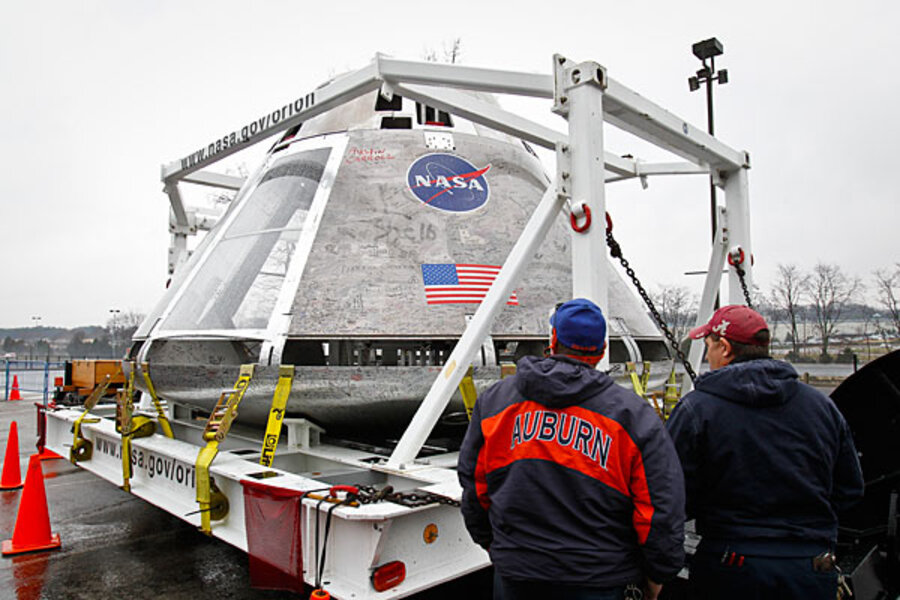Is NASA giving up on Mars?
Loading...
As expected, NASA’s 2013 budget request calls for an overall decrease in funding, with especially tough cuts to planetary science and education. The budget proposal of $17.7 billion is a decrease of 0.3% or $59 million from the 2012 budget and puts NASA at its lowest level of funding in four years. President Obama’s budget request for NASA includes a flat budget through 2017, with no out-year growth even for inflation.
Using the phrase “very difficult fiscal times” countless times, NASA Administrator Charles Bolden tried to put an upbeat spin on the bad news during a press conference on the budget on February 13.
“We are having to make tough decisions because these are very difficult fiscal times,” he said. “However this is a stable budget that allows us to support a diverse portfolio and continues the work we started last year.”
While the proposal includes continued funding for the agency’s human space programs —including $4 billion for space operations and $4 billion for human activities for the International Space Station, nearly $3 billion for the heavy-lift Space Launch System and Orion MPCV, along with $830 million for the commercial crew and cargo — planetary science took a huge hit, especially the Mars science program, considered by many to be the “crown jewel” of NASA’s planetary program.
Mars exploration would be cut by a whopping 38.5 percent, going from $587 million this year to $361 million in 2013. As predicted NASA has pulled out of the Exo-Mars collaboration with the European Space Agency, for dual Mars missions in 2016 and 2018, with no future flagship missions even in the offing, beyond the $2.5 billion Mars Science Laboratory rover, now on its way to Mars.
“Flagship missions are essential for the nation,” said Bolden when asked about what could be expected for future missions, “but we just could not afford to do another one right now given the budget an these difficult fiscal times.”
The Science Mission Directorate budget, which includes planetary exploration, astronomy and Earth environment monitoring, would receive $4.911 billion in 2013 instead of the $5.07 billion it received in 2012.
The NASA education budget was cut $36 million, down from $136 million in 2012 to $100 million in 2013.
The only bright spot for potential future planetary missions is that funding for the re-start of making Plutonium-238, the power source for outer-planet missions – is included in the 2013 budget. However, the cut to exploration missions means there is no funding for any new mission to study the moons of Jupiter or a Uranus orbiter, two projects that were a high priority in the Decadal Survey released by the science community in 2011. The reduction might also affect ongoing missions such as the remaining Mars Exploration Rover, Opportunity, the Mars Reconnaissance Orbiter, and the Cassini spacecraft orbiting Saturn. Those missions will be reviewed by NASA later this year.
This cut to planetary science has already been decried by many including the Planetary Society, which said the new proposal pushes planetary science “to the brink.”
“The priorities reflected in this budget would take us down the wrong path,” said Bill Nye, CEO of the Planetary Society. “Science is the part of NASA that’s actually conducting interesting and scientifically important missions. Spacecraft sent to Mars, Saturn, Mercury, the Moon, comets, and asteroids have been making incredible discoveries, with more to come from recent launches to Jupiter, the Moon, and Mars. The country needs more of these robotic space exploration missions, not less.”
The James Webb telescope, notorious for its cost overruns and delays, would get $627.6 million for 2013, up from $518.6 million in 2012 and $476.8 million in 2011. Many see JWST as responsible for draining money away from planetary science. JWST won’t launch until 2018 at the earliest.
Bolden said since NASA “replanned” JWST, they receive an accounting each month and so far the mission has been on-budget and on-time as far as meeting goals. “Through diligence and really paying attention to the budget and timeline, I think we can get this mission done,” Bolden said.
Two other bright spots in the budget was that funding for Earth observation satellites would be the same as 2012, at about $1.8 billion and the Space Technology program would get $699 million, up from the $569 million Congress approved for 2012.
As far as the human side, most officials were pleased with the numbers. The commercial Space Federation put out a statement saying that the “Commercial Crew program will enable American providers to free us from dependence on the Russian Soyuz for access to the International Space Station, a facility that American taxpayers have invested nearly $100 billion to build. NASA currently pays Russia more than $60 million per seat to access the Space Station, a price that is expected to rise above $70 million in the next few years.”
Executive Director Alex Saltman added, “With the Shuttle fleet retiring last year, Americans look forward to the day when we return our astronauts to space on American rockets. We are pleased that the Administration is requesting the funding necessary to make that happen. Now it’s Congress’s job to help put America back in space.”
As bad as the budget seems, according to some sources, things could have been much worse. The White House Office of Management and Budget had earlier asked NASA to submitted budget proposals at a 5, 10 or 15 percent cut. They may have been lucky to get only a .3% cut.
Here’s NASA’s upbeat video about the new budget:
This post originally appeared in Universe Today.







